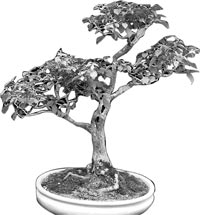
Bonsai: A constantly growing artIf you hear the word art, you would probably think of sculptures, paintings, poems or music, but a small tree in a shallow pot would probably not be what you would picture . But this is exactly what a Bonsai (“Bon” – Japanese for shallow pot and “Sai” – tree), the cultivation of a small tree as a miniature imitation of nature, is considered to be.
“Growing a Bonsai is like painting a never ending picture, because the canvas is not dead - the tree is under a constant growth,” says Hermie de Livera who has raised more than 60 Bonsai trees of her own and is a member of the oldest Bonsai association in Sri Lanka. The Bonsai Club of Sri Lanka, which was begun following the visit and workshop of an Indian Bonsai specialist to Colombo in 1980, mainly focuses on plants native to Sri Lanka or the subcontinent. “We should embrace the beautiful plants that we have in our country by using them for Bonsais, although they need more care,” says Ms. de Livera proudly. Bonsai can be grown from various woody trees but low branches, small leaves and a well developed root-system are required. The healthy plants’ roots and branches should be cut down to a smaller size, from a few inches to four feet before being planted into a proportionate pot. After having placed the plant in the special layered soil, consisting of clay tile, granulate, garden soil and sand, the small tree can be cut into countless shapes and grown to reflect numerous styles like “windswept”, “formal”, “landscape”, “slanting” and “cascade”. The most common form is the “Formal Upright”, which can easily be grown from a Ficus, the Woodapple, Cypress or a Pine and has a triangular shape, easily recognisable by its straight trunk and broad apex. Depending on its growth, a Bonsai has to be cut down at least every three to six months and for proper maintenance it has to be repotted every two years. Sri Lankan Bonsais need to be watered more often, repotted more frequently and have no dormant period, which makes them more difficult to maintain than the Japanese pot-plants. The club held its 20th exhibitionin at Colombo’s Art Gallery recently, displaying over 100 Bonsai trees, of which some were sold to enthusiastic visitors. Currently the club, which was founded by Rev. Fr. Artie Amaratunga, consists of 15 members, who meet regularly to discuss the growing and treatment of plants, plan the biennial exhibitions or prepare workshops. Most of their members have joined the club at the inception and have now throughout their constant exchange of ideas and advice with consultants from other countries, like Japan and the Netherlands, become experts in the field. “Many young people in Sri Lanka are interested in bonsai but most of them are involved in high-powered jobs which leave them very limited free-time,” Mrs. de Livera states. Although the art of growing Bonsais is a rather time-consuming hobby because the plants have to be watered daily, fertilized frequently and constantly taken care of, it is known to have a calming effect which brings the practitioner the benefit of peace and relaxation, she adds. |
|| Front
Page | News | Editorial | Columns | Sports | Plus | Financial
Times | International | Mirror | TV
Times | Funday
Times || |
| |
Copyright
2007 Wijeya
Newspapers Ltd.Colombo. Sri Lanka. |
